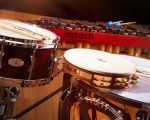How Musical Instruments Create Sound: The Science Behind the Music
Have you ever wondered how a guitar makes a sound when you strum its strings or how a trumpet produces a bold note with just a puff of air? Music is made up of various beautiful sounds, and understanding how musical instruments create sound can give you a deeper appreciation for the art. In this article, I’ll explore how different types of musical instruments generate sound and the science behind it, from string instruments to wind and percussion.
1. The Basics of Sound: Vibration and Frequency
All musical instruments create sound through vibration, a fundamental concept in the physics of sound. When you play an instrument, it sets something—such as a string, air column, or membrane—into motion. This vibration causes the surrounding air particles to vibrate, creating sound waves that travel to your ears.
a. Frequency and Pitch
The frequency of the vibration determines the pitch of the sound. High-frequency vibrations create high-pitched sounds, while low-frequency vibrations create low-pitched sounds. For instance, when you pluck a string on a guitar, the length and tension of the string affect the frequency at which it vibrates, thus determining whether it produces a high or low note.
b. Amplitude and Volume
The amplitude of the vibration controls the volume. Larger vibrations produce louder sounds, while smaller vibrations generate quieter ones. The intensity of the sound produced by an instrument is influenced by how hard you play it and how much the vibrating material can move.
2. String Instruments: Vibrating Strings
String instruments like guitars, violins, and pianos produce sound through the vibration of their strings. When you pluck, bow, or strike a string, it vibrates at a particular frequency. The sound board (like the body of a guitar or violin) amplifies the sound of the vibrating string by transmitting the vibrations through the air.
a. How Guitar Strings Work
The vibration of the guitar string is determined by its tension, length, and thickness. Tightening the strings makes the pitch higher, while loosening them lowers the pitch. The resonating body of the guitar amplifies the sound by transferring the vibrations of the string into the air.
b. The Role of the Bow in Violins
In a violin, the bow draws across the strings, causing them to vibrate. The friction between the bow and the string creates motion, which results in the vibration that produces sound. The violin's hollow body amplifies these vibrations to make the sound loud enough to hear.
3. Wind Instruments: Moving Air
Wind instruments like flutes, trumpets, and saxophones create sound by moving air through a tube or pipe. The vibrations of the air inside the instrument produce sound waves that travel out and reach our ears.
a. How a Flute Creates Sound
In a flute, air is blown across an opening, and the air stream is split by the edge of the hole, causing the air inside the flute to vibrate. The length of the tube and the manipulation of finger holes change the pitch by altering the frequency of these vibrations.
b. Trumpets and Brass Instruments
Brass instruments like trumpets rely on the player’s lips buzzing to create vibration. The lips act as the vibrating source, and the length of the tube is altered by valves that change the air flow. This alteration allows the player to reach different pitches and create unique tones.
4. Percussion Instruments: Vibrating Membranes or Materials
Percussion instruments like drums and cymbals create sound through the vibration of a material such as a membrane or metal when struck. These instruments are unique in that they often produce an immediate, sharp sound upon impact.
a. How Drums Produce Sound
In drums, the drumhead (often made of animal skin or synthetic material) vibrates when struck with a drumstick or hand. The tension and thickness of the membrane determine the pitch and tone of the sound produced. The drum shell also plays a part in amplifying the sound.
b. Cymbals and their Vibrations
Cymbals create sound through the vibrations of metal. When struck with a mallet or other object, the cymbal vibrates and creates a sharp, ringing sound. The material and shape of the cymbal determine its tonal quality and volume.
5. Electronic Instruments: Sound Creation through Electricity
Unlike traditional instruments that rely on physical vibrations, electronic instruments such as synthesizers and electric guitars create sound through electrical signals. These instruments use oscillators and sound waves generated by electricity, which are then amplified and converted into sound.
a. How Synthesizers Work
Synthesizers create sound by manipulating electrical signals produced by oscillators. The signals are then passed through filters and effects to modify their tone. Synthesizers offer a wide range of sounds, from imitating real instruments to creating entirely new, electronic noises.
b. Electric Guitars and Amplifiers
An electric guitar produces sound through its pickups, which convert string vibrations into electrical signals. These signals are then sent to an amplifier, which boosts the signal and produces sound through the speakers. The tonal quality is affected by the settings on the guitar and amplifier.
6. The Importance of Resonance in Sound Production
Resonance plays a crucial role in amplifying sound in many musical instruments. It occurs when an object or system vibrates at a particular frequency, amplifying the sound produced. This principle is evident in almost all musical instruments, from string to wind to percussion.
a. The Resonating Body in String Instruments
In string instruments, the resonating body (like the hollow body of a guitar or violin) amplifies the vibrations produced by the strings. Without this resonating body, the sound would be much quieter and less distinct.
b. Resonance in Wind Instruments
In wind instruments, the length and shape of the air column inside the instrument create resonance. The vibrating air column produces specific pitches, and the shape of the instrument determines the tonal quality and volume.
Conclusion: The Science Behind the Music
Understanding how musical instruments create sound is an essential part of appreciating music on a deeper level. Whether it's through vibrating strings, moving air, or striking percussion, each instrument uses unique methods to produce sound. The science behind these processes enriches the experience of both playing and listening to music, making it even more fascinating to explore.








